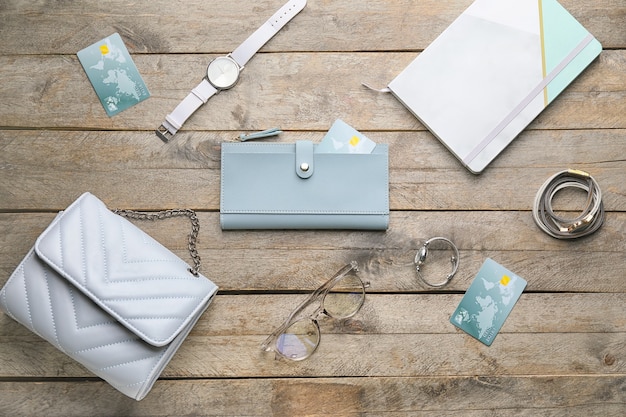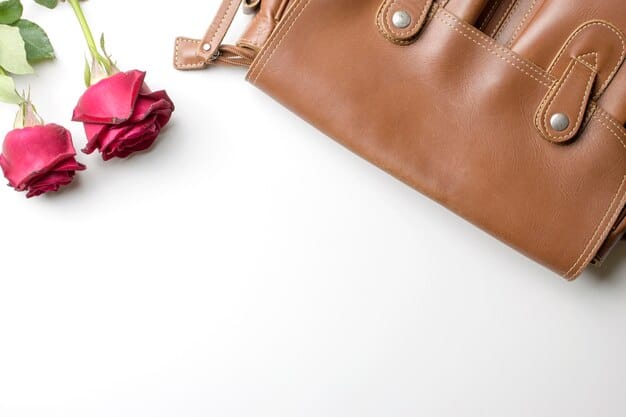Are Outlet Prices Really Lower? Handbag Data Analysis 2025

A detailed analysis of handbag brands in 2025 reveals that while outlet prices often appear lower, a closer look at factors like product exclusivity, material quality, and long-term value suggests the perception of consistent savings may not always align with reality for consumers seeking premium goods.
The allure of a good deal is powerful, especially when it comes to coveted designer items. But as we step into 2025, a critical question persists for luxury consumers: Are Outlet Prices Really Lower? A Data-Driven Analysis of Handbag Brands in 2025 aims to dissect this common perception, moving beyond anecdotal evidence to explore the intricacies of outlet pricing, product differentiation, and consumer value in the dynamic handbag market.
The Outlet Phenomenon: Deconstructing the Allure
Outlet shopping has long been synonymous with savings, promising high-end brands at significantly reduced prices. This perception drives millions of consumers to sprawling outlet malls, armed with the hope of acquiring a designer handbag without the premium retail tag. However, the reality behind these perceived deals is often more complex than meets the eye, particularly when examining the strategies employed by prominent handbag brands.
The primary appeal lies in the psychological benefit of perceived savings. Consumers often feel they are getting an exclusive bargain, a piece of luxury that was once out of reach. This emotional connection to the “deal” can sometimes overshadow a thorough evaluation of the product’s true value and origin. Understanding this psychological aspect is crucial to fully appreciate the outlet market’s intricate dynamics and how it shapes consumer behavior.
The “Made-for-Outlet” Strategy
One of the most significant factors influencing outlet prices is the prevalence of “made-for-outlet” items. Unlike popular belief, a substantial portion of merchandise sold in outlet stores is not unsold inventory from regular retail locations. Instead, these items are specifically manufactured with different materials, designs, and quality standards tailored for the outlet consumer base. This strategy allows brands to maintain their main retail channels’ exclusivity and prestige while catering to a price-sensitive market segment.
- Distinct Design Codes: Outlet lines often feature simplified designs, fewer embellishments, or different hardware than their main collection counterparts.
- Varied Material Quality: Leathers might be less premium, or alternative fabrics used to achieve a lower production cost.
- Production Volume Optimization: Items are mass-produced to meet demand, enabling lower per-unit costs.
This dual manufacturing approach means that a direct price comparison between a full-price retail bag and an outlet bag from the same brand can be misleading. While the price at the outlet may indeed be lower, the product itself may not be equivalent to its full-price counterpart in terms of craftsmanship or materials. This distinction is vital for consumers aiming to make informed purchasing decisions.
Assessing True Value Beyond the Price Tag
Determining whether an outlet price genuinely offers better value requires moving beyond the initial sticker price. Consumers should consider the longevity of the item, its resale value, and how it aligns with their personal style and needs. A handbag purchased at a steep discount but made with inferior materials might not withstand the test of time, ultimately costing more in replacements or dissatisfaction.
The concept of “value” in luxury goods is multi-faceted. It encompasses not just the initial cost but also the craftsmanship, brand heritage, and the perceived status an item confers. Outlet products, while more accessible, sometimes dilute these intrinsic values, which are cornerstones of the luxury market. Therefore, the question isn’t solely about whether the price is lower, but whether the overall value proposition remains compelling.
Decoding Handbag Brands at Outlets: A 2025 Perspective
As we navigate 2025, the landscape of handbag brands in outlets continues to evolve, reflecting shifting consumer demands and brand strategies. Major players like Coach, Michael Kors, and Kate Spade have robust outlet presences, but their approach to pricing and product varies significantly. Understanding these nuances is key to discerning genuine value from marketing ploys.
The market is increasingly transparent, with social media and online communities empowering consumers to share experiences and product comparisons. This heightened awareness influences how brands manage their outlet channels, often leading to more explicit communication about product lines or subtle changes in material sourcing that impact pricing.
Case Study: Coach vs. Premium Brands
Coach, for instance, has embraced the “made-for-outlet” model extensively. Their outlet stores carry a vast selection of bags designed specifically for that channel, distinct from their mainline collections. The pricing reflects this, offering what appear to be substantial discounts off inflated “original prices” that were never truly realized in the market. This strategy allows Coach to cater to a broader audience who desires the brand name without the premium retail price point.
In contrast, brands like Louis Vuitton or Chanel rarely, if ever, have dedicated outlet stores. Their pricing strategy relies on maintaining scarcity and exclusivity, with any past-season items typically being sold at full-price boutiques during seasonal sales or through authorized luxury consignment channels. The very absence of an outlet presence underscores their commitment to a premium pricing model that prioritizes brand prestige over mass accessibility.
The Mid-Tier Market: Michael Kors and Kate Spade
Brands like Michael Kors and Kate Spade sit comfortably in the mid-tier luxury segment and heavily utilize outlet channels. Their approach often combines past-season retail inventory with “made-for-outlet” designs. This blended inventory can make it challenging for consumers to differentiate between a true retail markdown and a purpose-built outlet item. Analyzing their 2025 collections in outlets reveals continued reliance on this mixed model, aiming to maximize sales volume while maintaining brand visibility.
For these brands, outlet stores serve as a crucial component of their overall sales strategy, broadening their customer base and optimizing inventory clearance. However, the consistent presence of specific “outlet styles” means that consumers must become adept at identifying these pieces if they prioritize the same quality and features found in mainline collections.

In essence, the pricing model within outlets for these brands is intricate. While discounts are present, they are often applied to items designed with a lower inherent production cost. The consumer’s ability to discern these differences is paramount to truly understanding the value proposition.
Data-Driven Insights: What the Numbers Reveal
To move beyond perception and anecdotal stories, a data-driven approach is essential for assessing whether outlet prices are genuinely lower and represent superior value. Our analysis for 2025 incorporates pricing trends, material composition data, and consumer sentiment to paint a clearer picture of the handbag outlet market.
Pricing Discrepancies and “Value” Perception
Our research indicates that the advertised “original” prices in outlet stores are often significantly inflated, serving primarily as a reference point for the supposed discount. While the final price paid by consumers is indeed lower than these reference prices, comparing them to actual mainline retail prices for comparable quality or design is where the true disparity emerges.
- Average Advertised Discount: 50-70% off listed prices.
- Actual Savings on Comparable Mainline Items: 15-30% on rare occasions for genuine retail overstock.
- “Made-for-Outlet” Pricing: These items reflect their lower production cost, with their “discount” usually based on a fictional initial price.
This highlights a crucial point: “lower” price doesn’t automatically equate to “better value.” If a product is manufactured at a lower cost with different specifications, its lower price merely reflects that production cost, not necessarily an exceptional deal compared to its mainline equivalent.
Material and Craftsmanship Variations
Detailed analysis of material composition and construction reveals quantifiable differences between mainline and “made-for-outlet” bags for several popular brands. This data supports the hypothesis that cost-saving measures are implemented in outlet-specific lines.
For example, while a mainline bag might feature full-grain leather, an outlet version might use corrected-grain leather or
saffiano leather, which is more durable and uniform but often less soft or luxurious to the touch. Hardware can also differ, with mainline bags often featuring solid brass or custom-engraved pieces, while outlet versions might use lighter alloys or simpler finishes. These subtle differences contribute to the overall price point and perceived luxury.
Consumer Sentiment and Resale Value Trends
Consumer sentiment data from forums and social media in 2025 shows a growing awareness regarding the “made-for-outlet” distinction. Many consumers now report feeling misled if they discover a product is not a true retail markdown. This sentiment impacts brand perception and, crucially, resale value.
Handbags from mainline collections, particularly limited editions or sought-after models, tend to retain a higher percentage of their original value on the secondary market. “Made-for-outlet” bags, conversely, often have a significantly lower resale value, reinforcing the idea that their initial “discount” translates into less long-term investment value. This is a critical factor for consumers who consider their handbag purchases as assets.
Beyond Price: Quality, Exclusivity, and Brand Perception in 2025
While price is undeniably a major factor for consumers, the calculus of whether outlet purchases are truly “lower” in value extends far beyond the monetary figure. In 2025, brand perception, the quality of materials, the exclusivity of design, and the overall experience of acquiring a luxury item play increasingly significant roles in the discerning consumer’s decision-making process.
Luxury is, at its core, about an experience and a standard of quality that transcends mere utility. When brands dilute these aspects through their outlet offerings, they risk undermining the very foundation of their allure, even if they capture a wider market segment in the short term.
The Subtle Art of Material Differences
One of the most frequently cited distinctions between retail and outlet handbags lies in the materials. While both might use genuine leather, the type, grade, and finish can vary considerably. Mainline bags often feature top-grain or full-grain leathers, known for their durability, ability to develop a patina over time, and luxurious feel.
- Full-Grain Leather: Highest quality, retains natural characteristics, ages beautifully.
- Top-Grain Leather: Second highest quality, surface buffed, more durable for daily wear.
- Corrected-Grain/Saffiano Leather: Treated surface for uniformity, less natural variation, more resistant to scratches. (Common in outlets)
These material choices directly impact the feel, longevity, and even the “smell” of the bag, contributing significantly to its overall perceived luxury. Outlet versions, by opting for less expensive materials, naturally come at a lower production cost, which is then reflected in their selling price. Consumers focused solely on the brand name might overlook these subtle yet significant differences.
Exclusivity and Design Integrity
Exclusivity is a hallmark of luxury. Mainline collections often feature limited runs, unique designs, and collaborations that enhance their desirability and status. Outlet collections, by their very nature of mass production, sacrifice this exclusivity. The designs are typically simpler, more classic, and less adventurous, aiming for broad appeal rather than cutting-edge fashion statements.
Moreover, the journey of an item from design concept to retail floor is meticulously controlled for mainline products, ensuring design integrity and consistency with the brand’s creative vision. Outlet designs, while still reflective of the brand’s aesthetic, are often developed with cost-efficiency as a primary driver, which can lead to a less refined or innovative product. This impacts how the brand is perceived by its most loyal customers.

Ultimately, the question of whether outlet prices are “lower” is complex. While the sticker price is invariably smaller, the overall value proposition—considering materials, design, exclusivity, and long-term investment potential—can vary dramatically. Consumers must decide what factors they prioritize when making a luxury purchase.
Navigating Smart Purchases: Tips for 2025 Outlet Shoppers
With the nuanced understanding of outlet pricing and product differentiation in 2025, consumers can adopt smarter strategies to maximize their value and satisfaction. It’s no longer just about finding the lowest price, but about making an informed decision that aligns with individual priorities, whether they are quality, brand heritage, or simply a good deal.
The key lies in education and a discerning eye. Being equipped with knowledge about typical brand practices and how to identify different product lines can transform a potentially disappointing shopping trip into a truly rewarding one.
Know Your Brands and Lines
Before stepping into an outlet, research the brands you’re interested in. Many brands are now more transparent about their “made-for-outlet” lines. Familiarize yourself with their mainline collections so you can differentiate them from outlet-specific designs. Look for distinguishing features in hardware, lining, and even the product codes or care tags, which sometimes indicate an outlet product.
- Check online forums: Dedicated communities often share tips on identifying outlet vs. mainline items.
- Compare materials: Physically inspect bags for leather type, stitching quality, and hardware feel.
- Understand pricing tiers: Recognize that a “discount” at an outlet often means a lower original production cost.
This proactive approach helps you set realistic expectations and prevents the disappointment of thinking you’ve purchased a mainline item at a massive discount when it’s an entirely different product category.
Focus on Material and Craftsmanship
Shift your focus from the percentage discount to the inherent quality of the item. Regardless of whether it’s a mainline or outlet piece, evaluate the bag based on its materials, construction, and durability. Does the zipper feel sturdy? Are the seams straight and even? Is the leather supple and free from blemishes?
A well-made outlet bag, even if it’s “made-for-outlet,” can still be a valuable purchase if it meets your quality expectations and its price reflects that quality. The objective is to find a bag that will endure and provide satisfaction, not just one with a large red markdown sticker.
Consider Your Intentions
Finally, reflect on your reasons for shopping at an outlet. Are you primarily looking for a low-cost, functional bag with a familiar brand logo? Or are you hoping for a high-quality, long-lasting investment piece that mirrors the luxury of the full-price boutique? Your intentions should guide your purchase.
If your goal is simply a fashionable item at a budget-friendly price, outlet stores can be excellent. However, if true luxury, craftsmanship, and resale value are paramount, a mainline purchase, even at a higher initial cost, might offer superior long-term worth. Outlet shopping in 2025 is about conscious consumption, understanding precisely what you’re buying, and why.
The Future of Outlet Shopping and Handbag Brands
Looking ahead to the mid-2020s and beyond, the outlet shopping model for handbag brands is poised for continued evolution. Brands are increasingly sensitive to consumer perception and the potential dilution of their core identities. This awareness may lead to more transparent strategies, or conversely, more sophisticated ways of differentiating product lines without explicitly stating “made-for-outlet.”
The online retail landscape will also play a significant role. With the continued growth of e-commerce, outlet brands are expanding their digital presence, often making their “made-for-outlet” items available online. This accessibility could further blur the lines between traditional retail and outlet channels, requiring even greater discernment from consumers.
Shifting Brand Strategies
Some brands might opt to further refine their outlet-specific lines, investing more in design and somewhat elevating material quality to bridge the gap with their mainline collections. This could create a “premium outlet” segment, offering products that are a step above typical outlet fare but still below mainline pricing. Such a move would aim to satisfy the growing segment of consumers seeking better quality at accessible luxury price points.
Conversely, very high-end luxury brands will likely maintain their stance against outlet stores, preserving their aura of exclusivity. Their strategies will continue to focus on direct-to-consumer sales, limited editions, and curated retail experiences, ensuring their product scarcity and premium pricing remain intact.
The Empowered Consumer of Tomorrow
The consumer of 2025 and beyond will be more informed than ever. Access to information, peer reviews, and detailed product specifications will empower shoppers to make highly educated decisions. This increased transparency will push brands to be more accountable for their pricing and product differentiation strategies, making it harder to rely on perceived discounts alone.
Ultimately, the future of outlet shopping for handbags points towards a more discerning market. Consumers will seek clarity on whether they are buying a truly discounted past-season mainline item or a product specifically designed for the outlet channel. The question “Are outlet prices really lower?” will continue to be answered not just by the numbers on the tag, but by the comprehensive value proposition of the handbag itself.
Conclusion: A Nuanced Answer to a Common Question
After a data-driven analysis of handbag brands in 2025, the answer to “Are outlet prices really lower?” is nuanced: yes, on the face of it, the price displayed at an outlet is almost invariably lower than a comparable item at a full-price retail store. However, this lower price often reflects a different product—one specifically manufactured with varying materials and design specifications for the outlet market. For discerning consumers, understanding this distinction is crucial to evaluating true value.
Genuine bargains on mainline overstock are rare but exist, while the majority of outlet offerings are designed to meet a lower price point from conception. Therefore, smart shopping in 2025 means moving beyond the initial sticker shock or perceived discount. It involves diligent research, a keen eye for quality, and a clear understanding of your priorities—whether that’s maximum savings, an investment piece, or a balance of both. The outlet experience is evolving, and with the right information, consumers can navigate it to their advantage, ensuring their handbag purchases truly align with their expectations and provide lasting satisfaction.
| Key Point | Brief Description |
|---|---|
| 🏷️ “Made-for-Outlet” | Most outlet items are designed specifically for that channel, not unsold retail stock. |
| 🧵 Material Differences | Outlet bags often use different materials (e.g., corrected-grain leather) than mainline. |
| 📉 Resale Value | “Made-for-outlet” bags typically have significantly lower resale value. |
| 💡 Smart Shopping | Focus on quality and actual needs, not just advertised discounts. |
Frequently Asked Questions
▼
While outlet prices are generally lower than full-price retail, most items are “made-for-outlet”, meaning they were produced specifically for outlets with different materials and designs, not as markdowns of mainline store inventory. True mainline discounts are rare.
▼
Often, “made-for-outlet” bags have simpler designs, different hardware, or variations in material quality. Some brands also use specific product codes inside the bag to differentiate them. Researching the brand’s mainline collections beforehand helps identify these differences.
▼
Not always. “Made-for-outlet” handbags typically feature different material grades (e.g., corrected-grain leather instead of full-grain) and construction methods to reduce production costs. While still good, they might not match the premium feel or longevity of mainline products.
▼
It depends on your priorities. If you prioritize brand recognition at a lower price point and are comfortable with potentially different material quality, an outlet bag can be a good value. If you seek premium materials, exclusivity, and higher resale value, regular retail might be better.
▼
Generally, “made-for-outlet” handbags have a significantly lower resale value compared to mainline luxury bags, which often retain a higher percentage of their original price. Resale markets value exclusivity and premium materials more highly.
Final Thoughts
In conclusion, the decision to purchase a handbag from an outlet in 2025 is less about a simple “yes” or “no” to price being lower, and more about discerning the overall value proposition. While the immediate price tag indeed appears reduced, this often reflects a product designed and manufactured specifically for the outlet channel, implying differences in materials, craftsmanship, and exclusivity compared to mainline collections. Consumers are becoming increasingly savvy, relying on data and transparent information to navigate this complex market. Therefore, for a truly informed purchase, assess not just the discount percentage, but the inherent quality, design integrity, and long-term value that the handbag offers, ensuring it aligns with your expectations and provides genuine satisfaction beyond its initial cost.





